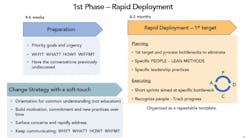You've Got an Urgent Business Case for Lean. Now What?
In today’s era of relentless disruption, businesses are seeking ways to step up the pace of improvement. While lean manufacturing has revolutionized efficiency, cost-cutting and quality, the new business paradigm demands a faster approach. This is where rapid deployment comes into the picture.
Case Study – Verde Valle
Verde Valle is a food company producing rice, beans and cereals, among other products. The urgent concern of the management team was falling behind in fulfilling the growth in orders because their capacity was limited. There were two options to increase capacity: invest in more equipment, space and hiring or implement process improvements. They chose lean and the clear objective to deliver growth with existing resources.
The Pillars of Rapid Deployment
The cornerstone of rapid deployment is significant improvements within six months by mobilizing people as an army of creative problem solvers to resolve one to two critical issues. At its core lies an urgent business case and a deeply rooted conviction for employee engagement.
Preparation
The initial phase lays the groundwork by establishing and broadly communicating the “Why” and “What” of the business case. An open discussion framed as ‘What's In It For Me?’ (WIFFIM) cultivates enthusiasm and individual investment in the project. Proactive measures are taken to address questions and uncertainties with the understanding that change brings both excitement and anxiety.
Planning
This phase adopts a targeted approach, focusing on a key strategic objective. The approach is to divide and conquer by breaking down the problem area into smaller, solvable pieces. This plan pinpoints those specific bottlenecks and areas of waste and carefully selects those specific employees who will be most instrumental in achieving the target. They are then equipped with relevant lean tools and methods.
Execution
Over four to six months, the action is iterative problem-solving. Each bottleneck is addressed in rapid cycles. This establishes a consistent rhythm of improvement that builds momentum and drives the effort forward. New information and insights are uncovered; the approach is refined. Contributions are acknowledged and progress is tracked.
Expansion
Planning and execution develop a culture of rapid action through employee engagement. We then begin to amplify the principles, processes and culture throughout the company, expanding to new targets and additional business areas. Preparation, planning and execution phases become a proven, repeatable template. In short, the expansion phase involves scaling up.






